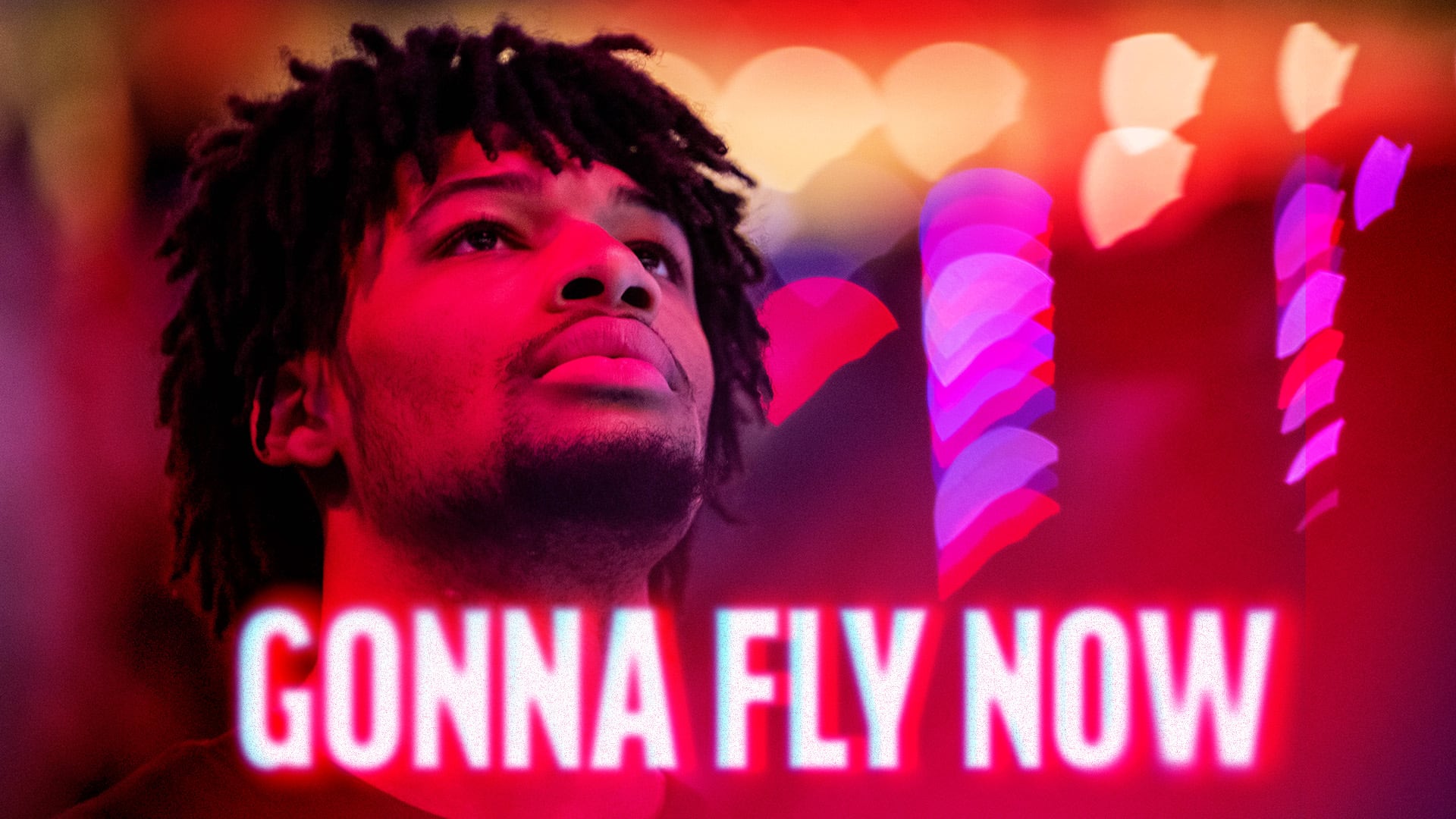For 50 years, our city has been shaped by a natural law: Portland is a better place when the Trail Blazers are good.
When the team is winning games and making playoff runs, people pack restaurants, bars and public transit on weeknights; strangers have something to talk to each other about; and more money circulates into the regional economy. (The Rose Quarter produces an economic output of $600 million annually, nothing to scoff at as Intel, Nike and OHSU appear to be collapsing in on themselves simultaneously.) The team is both an economic engine and one of the few remaining social glues holding the metro area together.
About a month ago, the Blazers turned into a good team—and people were mostly annoyed.
Coming into this season, the second since Damian Lillard’s abdication after an 11-year reign, most fans saw the team as lost in an aimless drift. The team was 13-28 on Jan. 18 and appeared ready to collapse over the back half of the season, as they’d done for the previous three years.
But as January turned to February, the team started playing tenacious, connected basketball and lighting their home crowds on fire.
Danny Marang covers the team for KATU-TV and KFXX-FM, and estimates he’s been to a thousand home games since he was a kid. How would he describe the feeling in the building during this stretch? “Life,” he says.
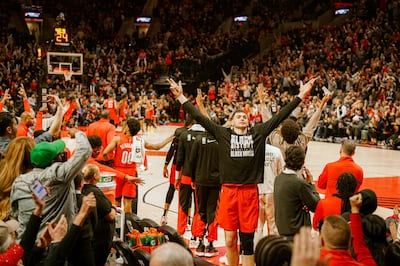
The resurrected Blazers won 10 of 11 games from Jan. 19 to Feb. 6, suddenly finding themselves 23–29 and a few games out of the play-in. But most importantly, a new core of young players emerged (see sidebar).
The improved record left many fans uneasy, however, as each win moved the Blazers further away from the chance to secure a top pick in a strong NBA Draft, headlined by potential cornerstones like Duke phenom Cooper Flagg.
Popular opinion holds that the Blazers still need to find one more player, a singular talent who can claim the franchise’s throne and deliver the title that past stars like Clyde Drexler, Brandon Roy and Damian Lillard have all fallen short of.
But, perhaps, this player is already on the team’s roster.
Probably the league’s biggest enigma, he has somehow managed to stay mysterious in an era of infinite digital exposure. That he ended up in Portland at all was highly unlikely, and came down to a combination of luck, the pandemic, a mid-’70s Canadian Parliament, and good old-fashioned riverboat gambler spirit on the part of the Blazers’ front office during the 2022 draft.
His name is Shaedon Sharpe. He is 21 years old. And a lot of Portland’s collective morale hinges on how good he’ll be when he’s 25.
For the years leading up to the night he first wandered onto an NBA floor, Sharpe was a shadow on the wall, more of a concept than an actual player.
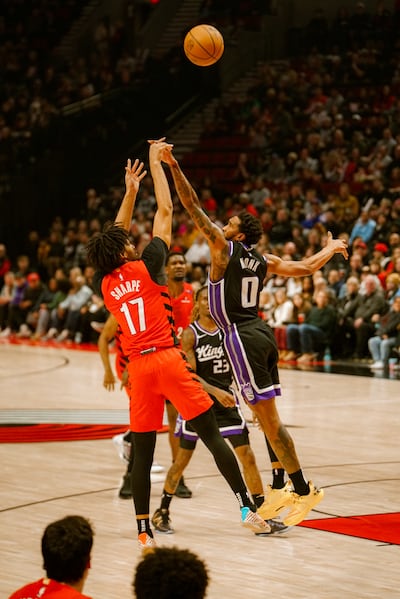
He played many of his high school games in empty gyms, and when he declared for the draft, he had never appeared on prime-time television or played in front of more than a few hundred people. So little was known about Sharpe when he turned pro that his pre-draft workout in Indiana was referred to as a stop on his “Magical Mystery Tour.”
Absurdly athletic even in a league of 450 of the world’s most absurdly athletic people, he is said to own a 49-inch vertical leap. Sharpe has, on at least three occasions, hit his head on the side of the backboard.
Physically, he seems built in a lab to play shooting guard in the NBA, standing 6-foot-5 with a wingspan over 6-foot-11. He has huge hands for a guard, 9 inches from the wrist to the tip of his middle finger. He has drawn comparisons to players like Kobe Bryant, Paul George, and Roy.
“It depends on what he wants to be,” says Sean Highkin, an independent journalist who covers the team through his publication and podcast The Rose Garden Report. “I think he has the talent to be a multiple-time All-Star, but this is a crucial time in his career....The offensive growth has been significant this season. It’s the other end of the floor that will determine whether he’s a true star or just a good scorer.”
Sharpe is sort of comically mild-mannered, but there has always been a sense that he possesses a deep level of faith in his own talent and destiny, and this occasionally comes through. Ahead of the draft, he was asked how he thought his career would go.
“I see myself being one of the greatest players to ever play the game of basketball,” he said.
Most young players speak with exaggerated bravado. But when Sharpe says something like this, almost casually, you can tell he actually believes it. And if you could do the things he could do, you probably would too.
Born in 2003, Sharpe is the first basketball player of any note to emerge from London, Ontario, a hockey town that has produced 59 NHL players.
He was so good and so out of place in London that he immediately took on an almost mythical status. Dave Sewell, who later became his private coach, first saw Sharpe as a 15-year-old playing in an open gym and was stunned by his raw talent. “You could tell from the get-go that he had a chance,” he told WW.

Long a basketball afterthought, Canada has produced 49 NBA players in the past 14 years, making it the top pipeline outside the States in an era increasingly defined by international players. Many of the 49 are first- or second-generation Canadians via countries in the Caribbean. (Both sets of Sharpe’s grandparents emigrated to Canada from Jamaica.)
Without 1976 legislation passed by the Parliament of Canada, which opened the country up to immigrants, none of this would have happened. And if the national pastime had been something that wasn’t as cold and expensive as hockey, maybe it wouldn’t have happened either. But it did, and thanks in no small part to Vince Carter and the Raptors, basketball prospered among the communities of newcomers in and around Toronto, Vancouver and Montreal.
Sharpe’s AAU team alone, UPLAY Canada, has put nine players in the NBA since 2018. (AAU is essentially a set of leagues for private travel teams of high school kids funded by shoe companies that serves as the proving ground for North America’s future pros.)
UPLAY’s founder, Dwayne Washington, is a former high school point guard from the Bronx who came to Canada for a postgraduate degree, and who doesn’t bother to sugarcoat his thoughts. Washington arranged for Sharpe to go to a prep school in Kansas, where he didn’t do much to distinguish himself.
Sharpe’s sophomore year, which was supposed to catapult him to the next level, was instead cut short by the pandemic. He went home to London and started training with Sewell again. “I’d say the biggest thing,” Sharpe tells WW, was that during the pandemic, Sewell “had a gym in the city and I was able to go in there and work out with him.”
Sharpe also began making 90-minute trips east to work out at UPLAY’s facilities in Hamilton, a faded steel town on the southwestern tip of Lake Ontario an hour south of Toronto. For the better part of a year—“hundreds of hours” in Washington’s words—Sharpe was transformed into an elite prospect through grueling training sessions.
Washington’s private sessions with Sharpe allowed him to put his prospect through the same workouts that other UPLAY alums now playing in the NBA had gone through. “Working out with him really took my game to the next level,” Sharpe says.
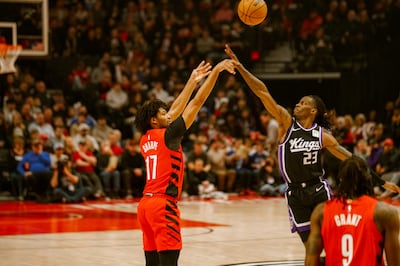
“He was really able to get that stuff that all these [NBA] guys were getting,” Washington told WW. “But he did it with no school—he didn’t have to go to school, it was all online. I was with him 24 hours a day pretty much. So you understand, he got 10 times the hours every single day. He accelerated the process.
“That is never going to happen again.”
A year later, Sharpe was in New York City, sitting at a table with his family, surrounded by television cameras, waiting to find out which city he’d be spending his 20s in.
The Blazers also found themselves facing a crossroads at the 2022 NBA Draft, where they held the seventh overall pick following a disastrous season in which Damian Lillard had missed 53 games.
The problem for Portland, and for all teams drafting in the lottery, was that Sharpe was as much of a mystery box as any high-end prospect ever to enter the draft. Nobody had enough background on him. He’d skipped his senior year of high school and enrolled at the University of Kentucky, where he never played in a game before declaring for the draft.
Two weeks before draft night in 2022, however, the Blazers hired a young scout named Mike Schmitz as one of Joe Cronin’s assistant GMs. Schmitz, for the previous three years, had been gathering intel on Sharpe, partly through his prior relationship with Dwayne Washington, who later told WW, “Mike Schmitz hits me every day.”
The Blazers stayed at seven and selected Sharpe.
Schmitz, to be clear, was only one voice in the Blazers’ front office when it came to Sharpe. But he was definitely its best-informed voice.
“I respect Mike because Mike stayed on it,” Washington says. “He saw something. Mike kind of saved the kid…because truthfully he was going to New Orleans [at No. 8] right after, guaranteed, it was a done deal. They got lucky.”
Exactly how lucky the Blazers were is still to be determined. Sharpe, now in the middle of his third season, is still a long way from hitting his ceiling.
As a rookie, he was thrown into the fire, playing 80 of 82 games, and acquitted himself remarkably well. He was promoted to the starting lineup in his second season, but suffered a core muscle injury and missed the season’s final 50 games.
This season, Sharpe picked up where he left off, displaying the same combination of tantalizing offensive gifts and lackadaisical defense that has defined his career. He scored 20-plus points in five straight games in January, but the team lost four of them. Blazers coach Chauncey Billups, who would later refer to his defense in this span as “atrocious,” pulled Sharpe from the starting lineup.

Given that nobody, including Billups by his own admission, seems to really understand Sharpe or what makes him tick, it was a risk that could have gone sideways. But he responded without ego, buying into his bench role and upping his defense.
Sharpe has every physical tool needed to become a good defender. And to be fair, because of his strange career path, he’s been trying to learn how to play substantive defense for the first time in his life while already at the game’s highest level. “I want to be a defensive player that nobody wants to go against,” he tells WW.
The team’s brass and Billups remain befuddled by Sharpe. “I never know until the game starts if I reached him,” Billups told The Athletic’s Jason Quick after benching Sharpe.
Toward the end of Sharpe’s rookie year, I talked to his trainer, Francis Kiapway, and asked him about the questions—which two years later still linger—around Sharpe’s enigmatic personality and motivating forces.
“That’s what I think [the coaches are] kind of asking in terms of, yo, what is it that’s gonna make him go crazy?…What I do is, I challenge him. And I don’t give a fuck. And I let him know that,” Kiapway said.
“That’s where you’re gonna see the alter ego come out—when you challenge him. And you don’t disrespect him…but he feels like you’re disrespecting him. I do that from the jump of the workout. And as he continues to hear your voice in terms of that, that’s where he gives you his best reps.”
Kiapway, 30, was born in Kinshasa, the capital of the Democratic Republic of the Congo, but emigrated with his family to Canada as a child, ultimately ending up in Hamilton. He started playing basketball and was introduced to Dwayne Washington, who helped him get a scholarship to Indiana’s Ball State. Somewhat undersized for a shooting guard, he played his entire collegiate career with a titanium rod in his leg following an injury. His drive and good nature have made him a popular figure everywhere he’s gone.
When Sharpe started working out for NBA teams, Kiapway became his right-hand man and moved to Portland with him after the draft. He’s been an invaluable part of Sharpe’s support system in Portland, part mentor and part drill instructor.
“He’s like a [big] brother I never had,” Sharpe says. “He’s one of the only people who can really push me. He just really understands me as a person and understands the way I play. It’s just a blessing to have him in my life.”
When Kiapway was young, he used to let a skinny kid who’d been cut from his high school team’s varsity named Shai Gilgeous-Alexander tag along with him to his 5 am workouts. “I kind of was showing him how to work,” he told me. “If Shaedon had Shai’s work ethic naturally, it would be a different story. That’s why I’m here, to kind of put that in him.”
Gilgeous-Alexander, 26, the face of the Oklahoma City Thunder, is UPLAY’s most distinguished alum. He’s also the betting favorite to win MVP this year.
Gilgeous-Alexander and Sharpe share a lot of similarities on paper, but there are also differences; Sharpe grew up in another world from the one that Gilgeous-Alexander and Kiapway grinded out of in Hamilton. Kiapway referred to Sharpe as “silver spoon” because he grew up in the suburbs.
He also added: “Shaedon is the most talented out of the [UPLAY] program.” At the time, it didn’t quite seem like a compliment.
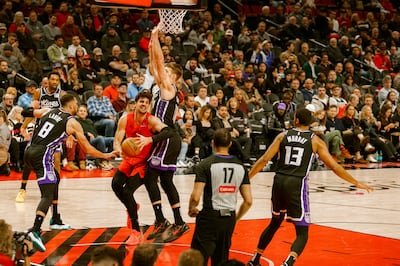
Seeing as the game comes so easily to him—and that unlike most great players in the league’s history he didn’t either (A) need to use it as a ladder out of poverty or (B) grow up with an Extremely Demanding Sports Dad—it’s fair to wonder what, exactly, motivates Sharpe to try to become a great player. Whatever it is, he’s the only one who knows, and even he may not fully understand it.
In the early stages of his career, Sharpe has put in more hours behind the scenes than just about any player. Even when Sharpe was still on his way to the Kiapway standard, Kiapway said: “He’s built a relationship with the [Blazers practice facility] janitors to where they’re like, man, this guy.”
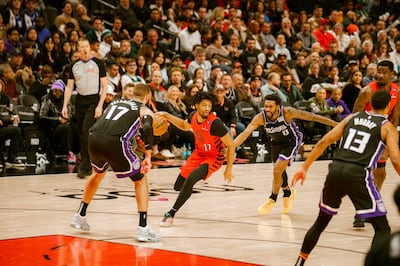
A vision of what Sharpe could become was on display Feb. 6 in Portland, when he scored 24 points off the bench in a win against the Kings and played the final 19 minutes to close out the game. In the third quarter, he hit a jaw-dropping fadeaway jumper from the top of the key. While running back down the floor he shook his head back and forth, admiring his own brushstroke. His defensive focus has been on the upswing, with Billups recently saying that he has “taken a huge step.”
The team, for its part, turned back into a pumpkin after beating Sacramento, losing their last three games before the All-Star break. They’ve kept playing hard, but injuries to their starters have started to pile up.
The biggest question facing Sharpe and the Blazers remains what kind of player he’ll be when he’s 25, about the age that you can start to draw definitive conclusions about players.
Marang thinks he could become an elite second option on a great team, but he remains skeptical about Sharpe as a top-shelf superstar on the level of Gilgeous-Alexander. “With Shaedon, I see a guy who could be an elite-level scorer, and an OK creator for others outside of himself,” Marang says. “But I still think they’re missing that guy.”
The Blazers currently have a 4.5% chance at the top pick in the coming draft. It seems they will go as far as Sharpe takes them.
Sharpe turns 25 in the late spring of 2028. If at that point he has put all the pieces together and managed to hit his ceiling, the Blazers would be entering an era of true title contention, and would have a shot at claiming their first title since 1977. The city could use a parade.
I asked Sharpe if he had a message for Portland. “What I want to accomplish is being the best player, or one of the best players, in this league,” he said. “I just want to let everybody know that it’s a process…and just to trust the process and believe in the practice.”
Blazers fans, haunted by past visions of star players fading into characters from a Greek tragedy, can have a harder time than most summoning trust. Our sandcastles always get dragged away by the tide. But perhaps you can hold on to the one idea that keeps hope alive: Maybe this time it will be different.
